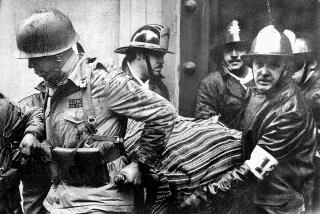Covert CIA Search in 1981 Found No POWs in Laos, Documents Disclose
- Share via
WASHINGTON — Senior Reagan Administration officials believed in 1981 that about 100 American POWs could have been left behind in Southeast Asia at the end of the Vietnam War, but efforts to rescue them were abandoned after a covert reconnaissance mission mounted by the CIA failed to find them, according to documents obtained by The Times.
The belief that, contrary to official policy statements, U.S. prisoners were still being held in Southeast Asia was based in part on a satellite photograph of a Laotian prison camp that the Reagan Administration received shortly after taking office in January, 1981.
In recent closed-door testimony to the Senate Select Committee on POW/MIA Affairs, a panel set up last year to investigate the fate of missing servicemen, former National Security Adviser Richard V. Allen said he and President Reagan believed on the basis of the satellite imagery that American POWs could have been imprisoned at the camp.
The CIA organized a mission to investigate the camp but took so long to do it that the site was abandoned by the time the team got there, Allen said. He added that the fear of failure precluded the launching of another mission.
However, according to Allen’s testimony, given in a June 23 deposition to committee investigators, the camp had “definitely” been inhabited in December, 1980, when the photograph was taken. More significantly, he said, the CIA concluded that the ground in the prison courtyard bore the markings of a numerical code used by American POWs in Vietnam.
The “rap code”--a sequence of numbers indicating the presence of POWs--had evidently been stamped into the ground by prisoners exercising in the courtyard in “a distinct pattern” repeated again and again over time, Allen said. The “genius of it,” he added, was that it could only be viewed from above, not from the ground, and it said “in effect . . . ‘Help From Above’ or “Here We Are.’ ”
Unofficial accounts of the reconnaissance mission and the CIA’s connection to it have appeared before in various forms. But Allen’s confirmation added details both about the May, 1981, mission to the camp at Nhom Marrot, in southern Laos, and the evidence that prompted Reagan to authorize it.
Allen’s testimony was made available to The Times as the committee concluded a series of hearings on the Pentagon’s handling of hundreds of newly declassified live sighting reports about Americans reported to have been in captivity in Vietnam and Laos long after the last POWs were returned during Operation Homecoming in 1973. Also made available was a memorandum Allen wrote to the committee in response to questions about an alleged Vietnamese offer to ransom POWs in 1981.
In two days of intense and often skeptical questioning, a panel of senior Pentagon officials and analysts from the Defense Intelligence Agency, which is in charge of the search for missing servicemen, maintained that most of the reports in the committee’s possession contained fabricated or otherwise false information. They said there is as yet no convincing evidence that any POWs were held in Southeast Asia after the war.
While congressional sources noted that Allen’s interpretation of the 1980 photograph in no way disproves that assertion, they viewed it as significant for two reasons. It shows that, despite the longstanding official position that there is no conclusive evidence that POWs were held after the war, the Reagan Administration clearly believed that American soldiers had been left behind.
It also appears significant because, while no POWs were found, the circumstances under which the coded message was stamped into the ground make it appear unlikely that the photo was fabricated, one congressional source said.
Committee Chairman John F. Kerry (D-Mass.) has promised to eventually make all of the documents and depositions in the panel’s possession public in declassified form. But the Allen testimony has not been officially released yet.
Allen said he wanted to keep trying to find out where the prisoners had been sent, but that efforts to mount further reconnaissance missions were dropped after the first one failed.
“I would have liked to try again,” Allen said, but “I don’t think the bureaucracy was willing to risk it.”
More to Read
Get the L.A. Times Politics newsletter
Deeply reported insights into legislation, politics and policy from Sacramento, Washington and beyond. In your inbox twice per week.
You may occasionally receive promotional content from the Los Angeles Times.










